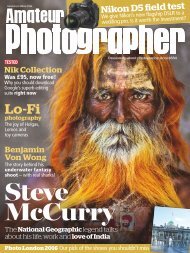You also want an ePaper? Increase the reach of your titles
YUMPU automatically turns print PDFs into web optimized ePapers that Google loves.
Planet Nine plus five<br />
Planet Nine<br />
Distant Kuiper Belt objects (magenta)<br />
Distant perpendicular objects (blue)<br />
A predicted outcome<br />
of Planet Nine’s<br />
existence is that a<br />
second set of confined<br />
objects should exist.<br />
They are forced<br />
into positions at<br />
right angles to Planet<br />
Nine and into orbits<br />
perpendicular to the<br />
solar system. Five<br />
known objects fit this<br />
modeling perfectly<br />
(shown in blue-green).<br />
CALTECH/R. HURT (IPAC)<br />
that it, too, was pulled in the same direction as all of<br />
the rest was again overlooked as mere coincidence.<br />
Trujillo and Sheppard did notice what they thought<br />
were some unusual orbital alignments, though, and, as<br />
was now common, suggested that a yet unseen planet<br />
— perhaps twice the mass of Earth and lying at a distance<br />
of 200 AU — was the natural explanation.<br />
At this point, Konstantin Batygin, a newly hired<br />
assistant professor at Caltech, and I became interested.<br />
We were pretty sure that the Trujillo and<br />
Sheppard suggestion wouldn’t work and quickly convinced<br />
ourselves that we were right (results that were<br />
also reached by Meg Schwamb, working in Taiwan).<br />
No planet could cause the alignments that Trujillo<br />
and Sheppard thought they were seeing.<br />
Looking carefully at the data, however, we became<br />
intrigued by these distant objects whose perihelia had<br />
been tugged away from the Kuiper Belt and by the fact<br />
that they were all coincidentally aligned. We quickly<br />
calculated that the probability of such an alignment<br />
occurring just due to chance would be only about 1<br />
percent, a small, but not overwhelmingly small,<br />
chance. I recall saying to Batygin, “This is interesting,<br />
but we really need one more object to be aligned to<br />
make it statistically convincing.”<br />
In a seemingly unrelated analysis, Rodney Gomes<br />
in Brazil noticed the existence of an unusually large<br />
number of objects with distant orbits whose closest<br />
approach to the Sun had been pushed inward even<br />
closer than the orbit of Saturn and whose orbits were<br />
twisted such that they were nearly perpendicular to the<br />
disk of the solar system.<br />
No one really had any viable suggestion for the origin<br />
of these peculiar objects. But Gomes had an interesting<br />
hypothesis: Perhaps a distant, massive planet<br />
was twisting these orbits perpendicularly and pushing<br />
their closest approaches inward.<br />
For anyone paying close attention to the outer solar<br />
system, it was 1820 all over again. Bouvard simply had<br />
Uranus to guide his way. This time there were multiple<br />
lines of evidence suggesting that perhaps an undiscovered<br />
planet was out there. Just as in 1820, the size, the<br />
orbit, and the mass were all completely unknown, but<br />
the hints that something was out there seemed to be<br />
coming from all directions.<br />
Meanwhile, Batygin and I saw the new object we<br />
had been waiting for when, in 2014, astronomers<br />
reported the discovery of 2013 RF 98<br />
, whose orbit is distant,<br />
elongated, and aligned nearly precisely like the<br />
rest. All of the most distant orbits were aligned. All of<br />
the distant orbits whose perihelia had been pulled out<br />
of the Kuiper Belt were aligned in the same direction.<br />
This time we calculated that the probability that this<br />
alignment was just due to coincidence was down to<br />
0.007 percent. The signs in the sky were clear:<br />
Something was out there.<br />
Batygin and I got to work. With months of penand-paper<br />
calculations, and then more months of<br />
detailed computer simulations, we realized that everything<br />
we were seeing could be explained by a planet a<br />
little less massive than Neptune on an eccentric orbit<br />
that takes it from around 200 AU at its perihelion out<br />
to 1,200 AU at its aphelion — its farthest point from<br />
the Sun — over an approximately 20,000-year orbital<br />
period. Such a planet would capture Kuiper Belt<br />
objects with distant elongated orbits into stable orbits<br />
elongated in the opposite direction from the planet.<br />
Moreover, it would pull the perihelia of these<br />
24 ASTRONOMY • JUNE 2016






